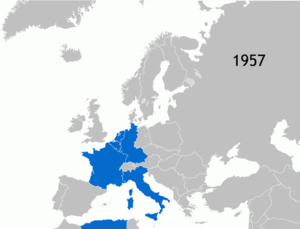Spaak Report
Part of a series on the |
||||||||||||||||||||||||
|---|---|---|---|---|---|---|---|---|---|---|---|---|---|---|---|---|---|---|---|---|---|---|---|---|
| History of the European Union |
||||||||||||||||||||||||
 | ||||||||||||||||||||||||
|
||||||||||||||||||||||||
|
Organisation
|
||||||||||||||||||||||||
|
||||||||||||||||||||||||
|
||||||||||||||||||||||||
|
Topics |
||||||||||||||||||||||||
| European Union portal | ||||||||||||||||||||||||
The Spaak report or Brussels Report on the General Common Market, was the report drafted by the Spaak Committee in 1956. The Intergovernmental Committee, headed by Paul-Henri Spaak presented its definitive report on 21 April 1956 to the six Governments of the Member States of the European Coal and Steel Community.
The report formed the cornerstone of the Intergovernmental Conference on the Common Market and Euratom at Val Duchesse in 1956 and led to the signature, on March 25, 1957, of the Treaties of Rome establishing a European Economic Community and the European Atomic Energy Community (Euratom).
Summary
The Spaak report concluded that a sector by sector integration of the European economies would be difficult. Instead a horizontal integration of the economy by the gradual elimination of trade barriers seemed to be the way to continue. This goal was to be achieved by creating a customs union.
On the integration of the energy sectors, there was a different stance for nuclear energy and for hydrocarbon energy sources (oil, coal). Integration of the European nuclear energy sector was desirable due the costs involved which surpassed the financial capacity of individual states. Integration of the development of nuclear energy at a supranational level meant more efficient cost sharing for the development of nuclear energy. The integration of hydrocarbon energy sources at a supranational level was less feasible, as these energy sources were managed mainly by multinational companies. The integration of electricity and gas seemed irrelevant since they were distributed solely at a national level.
See also
Source
- Spaak Report (English summary)
- Spaak Report (French)
- Treaties of Rome, preparation
- Interview with Jean François Poncet: the importance of the Spaak Report in the Val Duchesse negotiations (Paris, 16 March 2007)